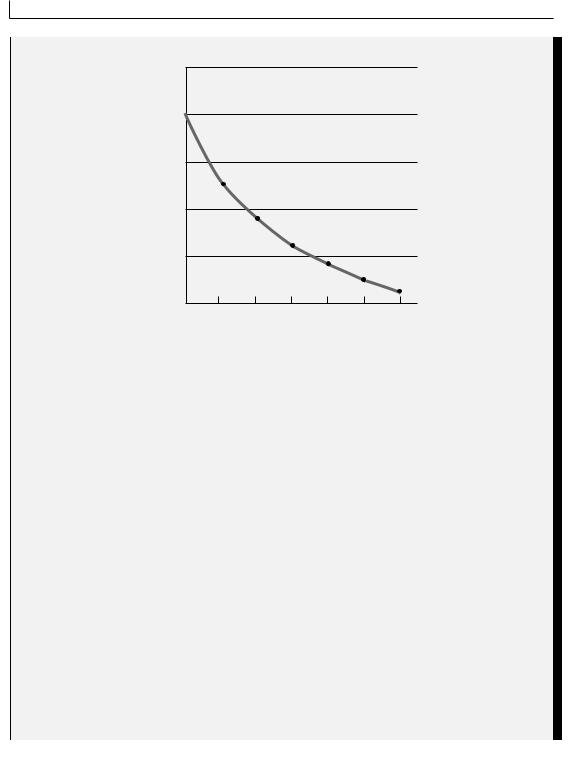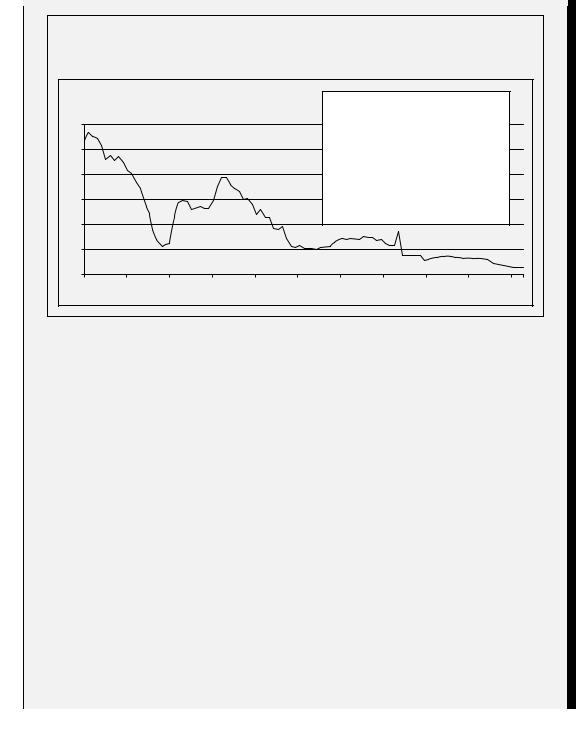
Global corporate finance - Kim
.pdf
42 MOTIVES FOR WORLD TRADE AND FOREIGN INVESTMENT
marketplace as single nations, they could lose their competitiveness in the world marketplace. While Japan is the dominant force in the area to take leadership in such an endeavor, neither the Japanese themselves nor the other nations wanted Japan to do it.
As a result, Asia does not have a strong trading bloc such as NAFTA or EU, but it has two loose affiliations: the Association of South East Asian Nations (ASEAN) and the Asian Pacific Economic Cooperation (APEC). Created in 1967, ASEAN consists of Brunei, Burma (currently Myanmar), Indonesia, Malaysia, the Philippines, Singapore, Thailand, and Vietnam; since then, ASEAN has added Cambodia and Laos. In November 2001, China and 10 ASEAN countries agreed to create a free trade area within 10 years. Trade liberalization already under way in the region, through the ASEAN Free Trade Area, which began in 2002, will cut tariffs on all foreign trade to a maximum of 5 percent by January 1, 2008.
APEC was formed in 1989 to promote multilateral economic cooperation on issues of trade and investment. APEC consists of 18 countries that account for half of world output and it includes the world’s three largest economies: the USA, Japan, and China. In 1994, APEC leaders agreed to achieve free and open trade in the region by 2010 for the industrial nations and 2020 for the rest of the members.
Japan has sought to cut the best trade deals for itself by negotiating through the multilateral World Trade Organization instead of making bilateral or regional pacts. This continued in recent years even as many countries around the world formed regional trading blocs, such as the NAFTA and the EU. However, Japanese officials and business executives have grown alarmed as regional blocs have continued to put Japanese exporters at a disadvantage. Thus, Japan and Singapore recently signed a bilateral free trade agreement, in a move that eventually could change the way in which Japan conducts its long-troubled trade relations. There has already been talk of Japan forging trade zones with such Pacific Rim countries as Korea, Mexico, and the USA. Other Asian countries have recently stepped up to cut their own trade deals with their fellow Asian countries and countries from other regions. For example, South Korea and Chile formed a free trade agreement in 2003, and the USA signed a free trade agreement with Singapore in 2004.
2.2.4Corporate response to trading blocs
Corporations’ investments are an important consideration in the proliferation of trading blocs. On the one hand, investments are made in various blocs to ensure continued access to the markets should protectionist barriers be erected. In a sense, this necessity may foster inefficiency, because investments would not be made with the objective of optimization in mind. However, if trading blocs attract nations with similar consumer profiles, these investments do make sense from an overall business-development and customer-service point of view. Regional strategies may, in turn, accelerate the concentration of the different markets that comprise the trading blocs.
Many companies may not have the resources or the time to invest in all of the emerging trading blocs. To ensure future competitive capability, many strategic alliances have been forged across national and regional borders in recent years. These alliances involve arrangements ranging from contract manufacturing to joint research and development. Corporate mergers have occurred across regional borders to guarantee access to blocs as local entities.
What impact will these corporate investments and alliances have on blocs and the argument that they are indeed basically protectionist? The “stateless” corporation may be able to move production and investment wherever it gets its best return without concern for a particular country or a region. Technology has made such transfer relatively swift and quite painless.

MOTIVES FOR FOREIGN INVESTMENT |
43 |
|
|
First, corporations and their assets can no longer be held hostage by a dismayed government or even a supranational organization. Second, it is becoming increasingly difficult to establish a product’s national/regional origin, which makes protectionist moves correspondingly difficult. Finally, the interdependence that is being formed by companies may also spill over in a major way to the national and regional levels as well. As has been shown recently, tariff barriers erected against Japanese and European imports into the USA have ended up hurting US businesses as well. In 1991, IBM urged the US government to remove an antidumping duty that it had imposed on certain computer display screens imported from Japan. The effect of this duty was that American-built computers using this component became uncompetitive against models built completely in Japan.
2.3 Motives for Foreign Investment
In recent years, many companies have been induced to enter into new and profitable markets abroad. Economic and political forces in the host countries, along with their desire to sell more abroad, are largely responsible for the expansion of direct foreign investment. Companies find it increasingly easier to reach foreign markets through direct investment. The product life cycle theory, the portfolio theory, and the oligopoly model have been suggested as bases for explaining and justifying foreign investment.
2.3.1The product life cycle theory
The theory of product life cycles explains changes in the location of production. When new products are introduced in home-country markets, their sales and profits tend to increase sharply until they reach maturity. Competition increases rapidly as these products approach their maturity point; this competition narrows profit margins. At this stage, companies may utilize foreign manufacturing locations to lower production costs and sustain profit margins.
This theory assumes that larger companies in highly advanced countries have a comparative advantage in new products over the companies in developing nations. Companies in developing countries, however, have a comparative advantage in fabricating mature products. Highly advanced technologies, highly educated labor resources, and abundant capital are essential to develop new products. They are readily available to larger firms in advanced countries. Larger markets and necessary alteration requirements in early production stages are additional reasons why larger companies in the developed areas of the world first introduce new products in the home-country markets.
As products become mature, product defects and technological imperfections inherent in new products are ironed out, so that the method of production becomes standardized. Competition begins to appear during the stage of market growth and becomes highly intensive during the stage of market maturity. At this point, some companies will shift their standardized manufacturing methods to developing countries for a number of good reasons:
1 Standard production methods require many unskilled workers.
2 Most developing countries have an abundant supply of unskilled labor.
3 Labor costs are lower in developing countries than in advanced countries.

44 MOTIVES FOR WORLD TRADE AND FOREIGN INVESTMENT
2.3.2The portfolio theory
The portfolio theory indicates that a company is often able to improve its risk–return performance by holding a diversified portfolio of assets. This theory represents another rationale for foreign investment. This theory rests on two variables: risk and return. Risk is the variability of returns associated with an investment project. Two projects may have the same long-term average rate of return. But one project may fluctuate widely in annual return while the other may have a stable return. A project whose returns fluctuate widely is said to be more risky than the other whose returns are stable.
Typically, only a few financial variables are known in advance. Business executives and investors are, basically, risk averse. Thus, they desire to minimize the overall degree of risk for their investment projects. Fortunately, there are many business situations in which the risks of individual projects tend to offset each other. As a consequence, successful diversification makes it possible for investors to have a portfolio with risk less than the sum of the risks of the individual projects in the portfolio.
A study by Levy and Sarnat (1970) indicated that a company is often able to improve its risk–return performance by holding an internationally diversified portfolio. The key element in the portfolio theory is the correlation coefficient between projects in the portfolio. When projects with low degrees of correlation are combined with each other, a company is able to reduce its risk of expected return. The Levy–Sarnat model assumes that foreign investment projects tend to be less correlated with each other than domestic investment projects. The economic cycles of different countries – the USA and Saudi Arabia, for example – do not tend to be totally synchronized. On the other hand, most domestic projects tend to be highly correlated with each other, because they depend on the same state of economy.
2.3.3The oligopoly model
If you decide to buy tennis balls in the USA, you will end up with one of four brands: Wilson, Penn, Dunlop, or Spalding. These four companies make almost all of the tennis balls sold in the USA. Together, these four firms determine the quantity of tennis balls and the price at which tennis balls are sold. Analysts say that only a small number of giant multinational companies in each major industry also dominate the world market in that segment.
An oligopoly exists where there are only a few firms whose products are usually close substitutes for one another. Because a few firms dominate a market, each of these firms has a large share of the market. Thus, the policies of one firm have repercussions on the other firms.
The oligopoly model offers a way of explaining why multinational companies (MNCs) invest in foreign countries. The oligopoly model assumes that business firms make foreign investments to exploit their quasi-monopoly advantages. The advantages of an MNC over a local company may include technology, access to capital, differentiated products built on advertising, superior management, and organizational scale.
Horizontal investments for foreign production of the same goods as made in a home market are made to produce operational economies of scale. A horizontal investment may reduce the number of competitors, eliminate duplicate facilities, and expand a firm’s operation in an existing product line. Vertical investments for foreign production of raw materials are usually made to control input sources. The control of input sources may make it possible for companies in an
MOTIVES FOR FOREIGN INVESTMENT |
45 |
|
|
oligopolistic industry to raise barriers to the entry of new competitors and to protect their oligopoly position. Some companies make defensive investments to prevent others from gaining an unanticipated advantage.
2.3.4Other studies of motives for foreign investment
Many foreign investors are motivated by strategic decisions. Although there are numerous sorts of strategic considerations, we can group them into two categories: those from the standpoint of investors and those from the standpoint of host countries.
CONSIDERATIONS FROM THE STANDPOINT OF INVESTORS Nehrt and Hogue (1968) suggested that companies invest abroad for several purposes:
1New markets.
2Raw materials.
3Production efficiency.
4New knowledge.
First, many companies attempt to satisfy local demand or expand their markets through foreign manufacturing locations. For example, Japanese automobile manufacturers have built their assembly plants in the USA to satisfy local demand and to expand their market.
Second, oil companies, mining companies, and lumber companies find it difficult or costly to obtain raw materials at home. Hence, they invest their money abroad to obtain these raw materials.
Third, some production efficiency-oriented companies look for low costs of production, such as low labor costs. This is one of the most important reasons why MNCs choose countries in Africa, Asia, and South America for their overseas investment.
Fourth, some companies invest abroad to seek new knowledge and managerial expertise. For example, German, Japanese, and Korean companies have acquired US-located electronic firms for their technology.
CONSIDERATIONS FROM THE STANDPOINT OF HOST COUNTRIES The National Industrial Conference Board (1969) surveyed a sample of 60 nations and found that many developing countries have various incentive programs for private foreign investments. They include tax incentives, tariff exemptions, financial assistance, remittance guarantees, administrative assistance, protection against competitive investments and imports, and protection against nationalization and political risk. These and other incentive programs would undoubtedly motivate MNCs to invest in those nations offering them.
MIXED CONSIDERATIONS Aharoni (1966) studied the process for foreign investment decisions. After surveying 38 American companies that had invested in Israel, he found the following investment motives:

46 MOTIVES FOR WORLD TRADE AND FOREIGN INVESTMENT
1Outside proposals, such as those from foreign governments.
2Fear of losing a market.
3The bandwagon effect, which means that successful foreign operations reported by a company induce competitors to go abroad.
4Strong competition from abroad in the home market.
In addition to these four motives, the survey also detected a number of auxiliary motives for foreign investment:
1Utilization of old machinery.
2Capitalization of know-how; spreading of research, development, and other fixed costs.
3Creation of a market for components and other products.
4Indirect return to a lost market through investment in a country that has commercial agreements with these lost territories.
2.4 A Synthesis of Foreign Trade and Investment Theories
Traditionally, economists concentrated on trade only at the national level, while management scholars focused almost exclusively on the behavior of MNCs. Both groups of scholars thus failed to incorporate trade and investment theories into a single theory of international involvement. This was not a serious problem when foreign trade was largely carried on by intermediaries, while producers remained at home. However, MNCs have recently crossed the confines of individual nation-states to carry on their operations throughout the world. Consequently, motives for foreign trade and investment are too closely interrelated with each other to consider them separately.
2.4.1Eclectic theory
The eclectic theory, associated with Dunning (1981), attempts to explain a logical link between the international allocation of resources and the exchange of goods between countries. In other words, this theory makes the case for an integrated approach to international economic involvement based on the advantages of both a country’s location and a company’s ownership. Loca- tion-specific advantages, such as natural resources and low labor costs, are advantages that are available only or primarily in a single location. Ownership-specific advantages, such as capital funds and technology, are advantages that favor MNCs over local companies. The eclectic theory implies that location-specific advantages favor a host foreign country, while ownership-specific advantages favor an investing firm. Thus, the eclectic theory helps to explain cross-country differences in patterns of MNCs’ international involvement.
When a company expands its operations beyond national borders for the first time, it tends to exploit a foreign country’s markets through exports. A company favors investment in a foreign country only if it is most profitable for the company to internationalize its advantages in that country. Dunning argues that a company is willing to invest in overseas production facilities if the company has the following three kinds of advantages:
1Ownership-specific advantages: this is the extent to which a company has tangible and intangible assets unavailable to other firms.

QUESTIONS 47
2Internalization advantages: it is in the company’s best interest to use its ownership-specific advantages rather than license them to foreign owners.
3Location-specific advantages: the company will profit by locating part of its production facilities overseas.
It is important to note that empirical tests of the eclectic theory show that the major part of foreign direct investment is made by large, research-intensive companies in oligopolistic industries. These companies find it profitable to invest overseas because they enjoy both location and ownership advantages.
SUMMARY
Several theories explain the motives for world trade and foreign investment. The theory of comparative advantage and the theory of factor endowments explain why countries exchange their goods and services with each other. The theory of comparative advantage depends on two assumptions. First, economic resources are unequally distributed among nations. Second, efficient production of various products requires combinations of different economic resources and different technologies.
Both the product life cycle theory and the portfolio theory provide a conceptual rationale for foreign investment. The product life cycle theory assumes that a country uses foreign manufacturing locations when products approach their maturity point. The portfolio theory maintains that a company invests overseas because internationally diversified portfolios of assets improve risk–return performance.
A synthesis of foreign trade and investment theories is needed to form a single theory of international economic involvement. We can integrate trade and investment theories into a model that demonstrates how these theories influence a firm’s choice of entry mode best suited to a particular country. The eclectic theory postulates that specific factors of both firm and country are necessary for a firm’s foreign investment. When it is most profitable for a multinational firm to internationalize its oligopolistic advantages in a given foreign country, it will invest in that country; otherwise, it will exploit the country through exports.
Questions
1Explain the theory of comparative advantage as a motive for foreign trade. What is the logic behind this theory?
2The theory of the product life cycle is used as a motive for foreign trade as well as a motive for foreign investment. Discuss this theory as a motive for both foreign trade and foreign investment.
3What are economies of scale?
4Describe reasons for trade protectionism.

48 MOTIVES FOR WORLD TRADE AND FOREIGN INVESTMENT
5Assume that world leaders attempt to reduce or eliminate artificial barriers to trade through many forms of economic integration. Describe the different types of economic cooperation.
6What are the major functions of the World Trade Organization?
7What are the major benefits of market integration?
8Why do many companies diversify their operations internationally when there are many opportunities for domestic diversification?
9Explain the oligopoly model as a motive for foreign direct investment.
10Lee Nehrt and Dickerson Hogue suggested that companies invest abroad for new markets, raw materials, production efficiency, and new knowledge. Discuss each of these four motives for foreign investment.
11What is the eclectic theory?
Problems
Assume that production possibilities data for the USA and Taiwan are as follows:
|
|
|
|
Production alternatives |
|
|
|
|
|
|
|
Country |
Product |
|
A |
B |
C |
|
|
|
|
|
|
USA |
Clothing |
0 |
30 |
90 |
|
|
Food |
30 |
20 |
0 |
|
Taiwan |
Clothing |
0 |
20 |
60 |
|
|
Food |
15 |
10 |
0 |
|
|
|
|
|
|
|
1What is the comparative cost of clothing and food in the USA?
2What is the comparative cost of clothing and food in Taiwan?
3Identify the product that each country should specialize in according to comparative advantage.
4Assume that both countries decided to specialize in a product according to the comparative advantage. With 1 food = 31/2 clothing terms of trade, the USA exchanges 10 tons of its food for 35 units of Taiwanese clothing. With the assumption that B is the optimumproduct mix, prepare a table such as table 2.2.
5With a fixed investment of $10,000, the USA produces more in both clothing and food than Taiwan. Does this mean that specialization and trade do not provide any benefits for the USA?

CASE PROBLEM 2 |
49 |
|
|
REFERENCES
Aharoni, Y., The Foreign Investment Decision Process, Boston, MA: Harvard University Press, 1966.
Ball, D. A. and W. H. McCulloch, International Business, Homewood, IL: Irwin, 1999, ch. 3.
Coughlin, C. C., “The Controversy Over Free Trade: The Gap Between Economists and the General Public,” Review, Federal Reserve Bank of St. Louis, Jan./Feb. 2002, pp. 1–21.
Dunning, J. H., International Production and the Multinational Enterprise, London: George Allen and Unwin, 1981.
Dunning, J. H. and S. Bansal, “The Cultural Sensitivity of the Eclectic Paradigm,” Multinational Business Review, Spring 1997, pp. 1–16.
Gruben, W. C., “Was NAFTA behind Mexico’s High Maquiladora Growth?” Economic and
Financial Review, Federal Reserve Bank of Dallas, Third Quarter 2001, pp. 11–21.
Levy, H. and M. Sarnat, “International Diversification of Investment Portfolios,” American Economic Review, Sept. 1970, pp. 668–75.
National Industrial Conference Board, Obstacles and Incentives to Private Foreign Investment, New York: Conference Board, 1969.
Nehrt, L. and D. W. Hogue, “The Foreign Investment Decision Process,” Quarterly Journal of AISEC International, Feb.–Apr. 1968, pp. 43–8.
Ronkainen, I. A., “Trading Blocs: Opportunity or Demise for Trade?” Multinational Business Review, Spring 1993, pp. 1–9.
Wall, H. J., “The NAFTA and the Geography of North American FreeTrade,” Review, Federal Reserve Bank of St. Louis, Mar./Apr. 2003, pp. 13–26.
Case Problem 2: The Fruits of Free Trade Under the World Trade Organization
The essential difference between free trade and protection is this: Under a system of free trade excellence of the product is the only means by which it can secure a market, while under protection an inferior article can dominate the market through the aid of legislation. The necessary effect of free trade is, therefore, to encourage efficiency in production, while the necessary effect of protection is to encourage skill in corruption. Prosperity is an abundance of commodities. The merit of any policy or system can be tested by its effect on the volume of commodities available for the use of the people.
William Bourke Cockran, In the Name of Liberty, 1925
In 1947, in Geneva, 23 countries signed the General Agreement on Tariffs and Trade (GATT), a voluntary association of countries designed to promote free trade. GATT members have held many talks since 1947 to expand and promote world trade. As shown in figure 2.3, such talks have resulted in vast tariff reductions for industrialized countries. Many developing countries have implemented similar tariff reductions. These tariff reductions have caused world trade to increase twice as fast as world output since 1950, thereby boosting the standard of living for millions of people around the world.

50 MOTIVES FOR WORLD TRADE AND FOREIGN INVESTMENT
(Percentage)
50
40
30
Average tariffs on imports in
industrial countries
20
10
0
1950 |
1960 |
1970 |
1980 |
1990 |
2000 |
Year
Figure 2.3 Progress on tariffs
Source: John D. Daniels and Lee H. Radebaugh, International Business, New York: AddisonWesley, 2002, p. 263.
The general trend around the world since World War II has been to reduce obvious trade barriers, such as tariffs. Tariff reductions through several rounds of trade negotiations are an indication not only that countries are committed to working jointly toward freer trade but also that tariffs are the easiest trade barrier to tackle. In addition, negotiating rounds have dealt with the increasingly important and complex nontariff issues. Nevertheless, many governments have replaced obvious trade barriers with less obvious forms of protection. A growing number of nontariff barriers, such as those shown in figure 2.4 and others, threaten to undo the good work.
The biggest change to emerge from the Uruguay Round of trade negotiations (1986–93) was the agreement to replace the GATT with the World Trade Organization (WTO). Under the WTO, there is a clearly defined dispute-settlement mechanism. This dispute-settlement system allows small and developing countries to have an influence for the first time in dealing with trade practices in other countries. Further, by bringing cases to the panel, accused countries may agree to settle before a ruling is made. Consequently, the WTO’s settlement body has had a much heavier caseload than existed under the old GATT system. China joined the WTO in 2001, thereby further legitimizing the idea of free trade. As of January 2003, the WTO consisted of 144 countries and 34 observer countries, all of which are in the process of applying for membership. Based in Geneva, Switzerland, the WTO has a staff of 550 individuals

|
CASE PROBLEM 2 |
51 |
|
|
|
|
|
|
|
|
|
|
|
|
|
Reduced tariff rates lowered trade barriers and helped stimulate economic growth in recent decades. A growing number of nontariff barriers, however, threaten to undo the good. Voluntary export restraints; antidumping laws; government subsidies; licensing, labeling and packaging restrictions; domestic-content laws and others have emerged as the new enemies of free trade.
Ratio of duties to imports (%)
Nontariff barriers: the new enemies of trade
|
|
|
|
|
|
1 |
Import quotas |
|
|
|
|
30 |
|
|
|
|
|
2 |
Voluntary export restraints |
|
|
||
|
|
|
|
|
3 |
Antidumping laws |
|
|
|
||
|
|
|
|
|
|
|
|
|
|||
25 |
|
|
|
|
|
4 |
Exchange rate controls |
|
|
||
|
|
|
|
|
5 |
Countervailing duties |
|
|
|||
|
|
|
|
|
|
6 |
Government subsidies |
|
|
||
20 |
|
|
|
|
|
7 |
Licensing, labeling, and packaging restrictions |
||||
|
|
|
|
|
8 |
Quality controls and technical standards |
|
||||
|
|
|
|
|
|
9 |
Domestic-content laws |
|
|
||
15 |
|
|
|
|
|
10 |
Political rhetoric |
|
|
|
|
|
|
|
|
|
11 Embargoes and sanctions |
|
|
||||
|
|
|
|
|
|
|
|
||||
10 |
|
|
|
|
|
12 |
Most/least-favored nation status |
|
|
||
|
|
|
|
|
|
|
|
|
|
|
|
5 |
|
|
|
|
|
|
|
|
|
|
|
0 |
|
|
|
|
|
|
|
|
|
|
|
1900 |
1910 |
1920 |
1930 |
1940 |
1950 |
1960 |
1970 |
1980 |
1990 |
2000 |
|
|
|
|
|
|
Year |
|
|
|
|
|
|
Figure 2.4 The tax on trade
from 60 different countries and a budget of 143 million Swiss francs. Today, WTO members account for 97 percent of world trade.
The WTO is a consensus-based organization: decisions are made by the entire membership. A majority vote is also possible, but it has never been used in the WTO and was extremely rare under the WTO’s predecessor, GATT. The WTO’s agreements have been ratified in all of the members’ legislative bodies. As shown in figure 2.5, the WTO’s top-level decision-making body is the Ministerial Conference, which meets at least once every two years. There have been five WTO Ministerial Conferences so far, held in Cancun, Mexico (November 2003), Doha, Qatar (November 2001), Seattle, Washington (November 1999), Geneva, Switzerland (May 1998), and Singapore (December 1996).
Below the Ministerial Conference is the General Council, which meets several times a year in the Geneva headquarters. The General Council also meets as the Trade Policy Review Body and the Dispute Settlement Body. At the next level, the Goods Council, the Services Council, and the Intellectual Property Council report to the General Council and meet frequently. At the last level, numerous specialized committees, working groups, and working parties deal with the individual agreements and other areas such as the environment, development, membership applications, and regional trade agreements.
The WTO Secretariat, with offices only in Geneva, is headed by a Director-General. Because decisions are only made by members, the Secretariat has no decision-making powers. Its main
